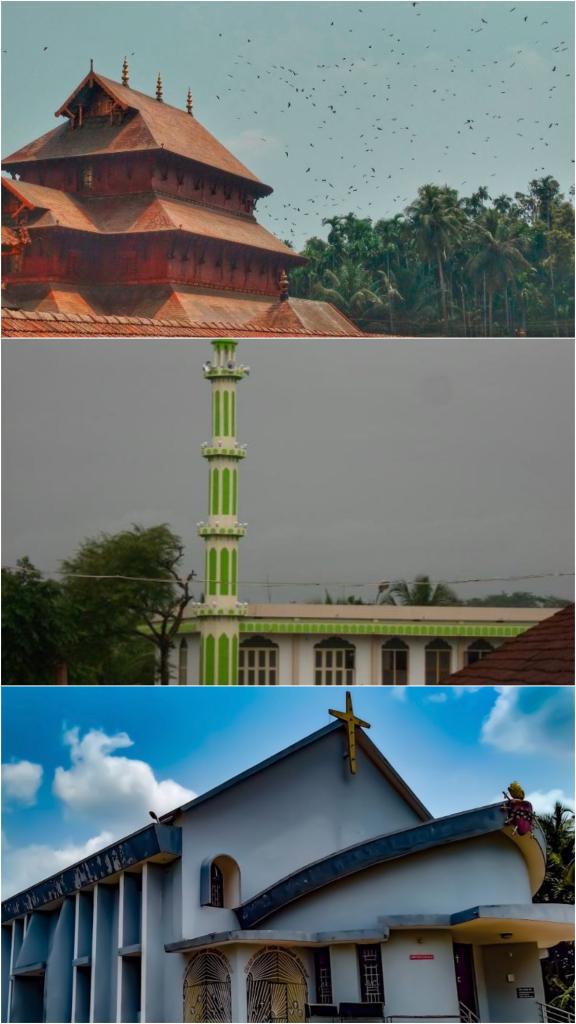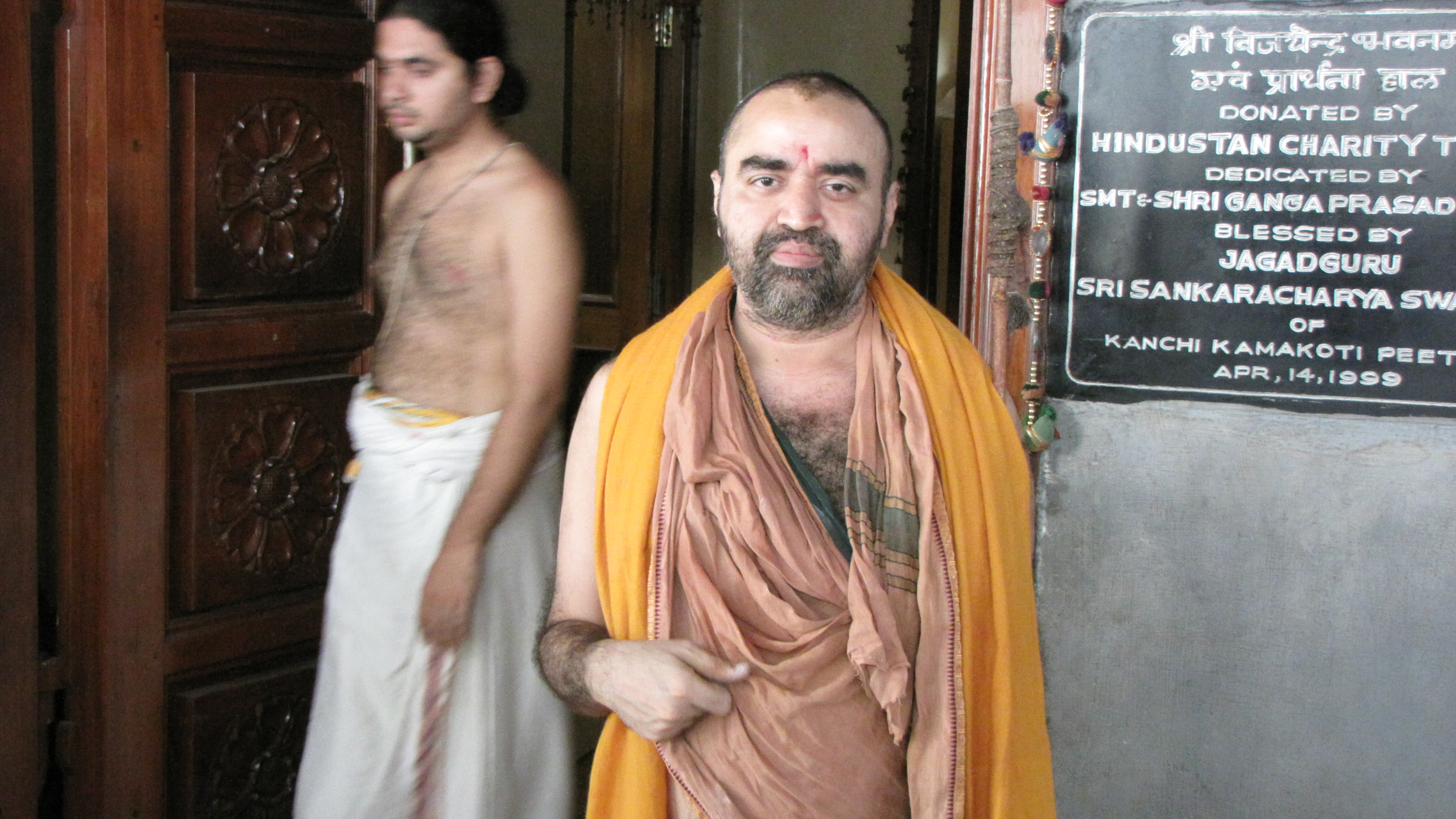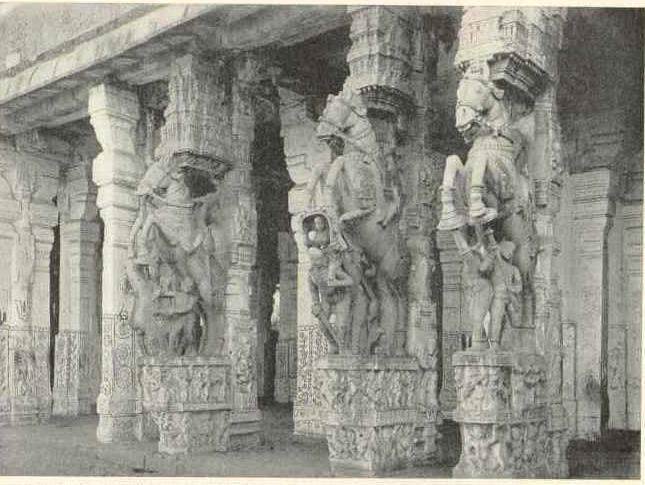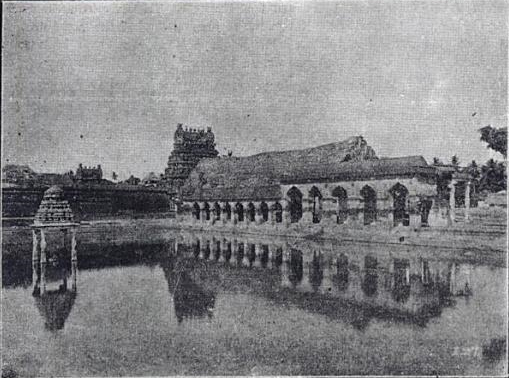|
Govindapuram, Thanjavur
Govindapuram is a village in the Thiruvidaimarudur taluk of Thanjavur district in Tamil Nadu, India. It is situated at a distance of 7 kilometres from Kumbakonam and 27 kilometres from Mayiladuthurai and 1 kilometre from Thiruvidaimarudur. It is said this is named after the minister Govinda Dikshita of Raghunatha Nayaka who ruled Thanjavur in 17th century. Demographics As per the 2001 census, Govindapuram had a population of 2,231 with 1,117 men and 1,114 women. The sex ratio was 997. The literacy rate was 86.29. There are a total of 516 households. Historical significance Govindapuram is the final abode of Kanchi Shankaracharya Bodhendra Saraswathi whose samadhi is located here. The samadhi is maintained by the Kanchi mutt. Govindapuram is also the centre of Sri Vittal Rukmini Samsthan which has constructed a temple to the Hindu god Vittal in this village. References * {{cite news, title=Breaking barriers, work=The Hindu ''The Hindu'' is an Indian English-la ... [...More Info...] [...Related Items...] OR: [Wikipedia] [Google] [Baidu] |
States And Territories Of India
India is a federal union comprising 28 states and 8 union territories, with a total of 36 entities. The states and union territories are further subdivided into districts and smaller administrative divisions. History Pre-independence The Indian subcontinent has been ruled by many different ethnic groups throughout its history, each instituting their own policies of administrative division in the region. The British Raj mostly retained the administrative structure of the preceding Mughal Empire. India was divided into provinces (also called Presidencies), directly governed by the British, and princely states, which were nominally controlled by a local prince or raja loyal to the British Empire, which held ''de facto'' sovereignty ( suzerainty) over the princely states. 1947–1950 Between 1947 and 1950 the territories of the princely states were politically integrated into the Indian union. Most were merged into existing provinces; others were organised into ... [...More Info...] [...Related Items...] OR: [Wikipedia] [Google] [Baidu] |
Thiruvidaimarudur
Thiruvidaimarudur (also spelt as Thiruvidaimaradur or Tiruvidaimarudur) is a panchayat town in Thanjavur district, in the Indian state of Tamil Nadu. The town is notable for its Mahalingeshwarar Temple, a Hindu shrine for Lord Shiva. Geography Tiruvidaimarudur is located at . It has an average elevation of . Demographics The 2001 Indian census recorded Thiruvidaimarudur as having a population of 13,758. Males and females each constituted 50% of the population. Thiruvidaimarudur has an average literacy rate of 74%, higher than the national average of 59.5%: male literacy is 80%, and female literacy is 68%. 11% of the town's population is under 6 years of age. Politics Thiruvidaimarudur assembly constituency is part of Mayiladuturai (Lok Sabha constituency). Govi. Chezhiyan is the current MLA of Thiruvidaimaruthur assembly constituency and the current MP of Mayiladuthurai Lok Sabha constituency S. Ramalingam is from Thiruvidaimaruthur. The temple About north-east of the Tem ... [...More Info...] [...Related Items...] OR: [Wikipedia] [Google] [Baidu] |
Vittal
Vitla (ವಿಟ್ಲ) also Vittal is a town in Bantwal taluk of Dakshina Kannada district, India, around 18 km from Bantwal in Bantwal Taluk. It is also 14 km from Puttur and 40 km from Mangalore. Vitla was an assembly constituency of Karnataka Legislative Assembly, but discontinued from 2008 elections. Agriculture is the main occupation of people in and around Vitla town. Arecanut, cocoa, pepper, Cashew and coconut are grown here. There is a regional station of Central Plantation Crops Research Institute (CPCRI) which conducts research on areca nuts, an important commercial crop in the area. It also researches cocoa growing, including its production, protection and increasing drought resistance. Formerly ruled by the Vittala Arasas or kings belonging to the Domba Heggade Dynasty, the head of the dynasty, even today, plays a dominant role in the religious ceremonies of 16 temples. One can see the palace in the outskirts of Vittla. Standing in the middle of the ... [...More Info...] [...Related Items...] OR: [Wikipedia] [Google] [Baidu] |
Sri Vittal Rukmini Samsthan
Shri (; , ) is a Sanskrit term denoting resplendence, wealth and prosperity, primarily used as an honorific. The word is widely used in South and Southeast Asian languages such as Marathi, Malay (including Indonesian and Malaysian), Javanese, Balinese, Sinhala, Thai, Tamil, Telugu, Hindi, Nepali, Malayalam, Kannada, Sanskrit, Pali, Khmer, and also among Philippine languages. It is usually transliterated as ''Sri'', ''Sree'', ''Shri'', Shiri, Shree, ''Si'', or ''Seri'' based on the local convention for transliteration. The term is used in Indian subcontinent and Southeast Asia as a polite form of address equivalent to the English "Mr." in written and spoken language, but also as a title of veneration for deities or as honorific title for local rulers. Shri is also another name for Lakshmi, the Hindu goddess of wealth, while a ''yantra'' or a mystical diagram popularly used to worship her is called Shri Yantra. Etymology Monier-Williams Dictionary gives the meaning of the ... [...More Info...] [...Related Items...] OR: [Wikipedia] [Google] [Baidu] |
Kanchi Mutt
Sri Kanchi Kamakoti Peetham, also called the Sri Kanchi Matham or the Sri Kanchi Monastery or the Sarvagna Peetha, is a Hindu institution, located in Kanchipuram, Tamil Nadu. It is located near a temple dedicated to Goddess Sri Kamakshi (Durga, Kamakoti, Maha Tripurasundari) of the Shaktism tradition, along with a shrine for the Advaita Vedanta teacher Adi Shankara. The matha-tradition attributes its founding to Adi Shankara, but this and the reliability of the matha's succession list has been questioned. The Kanchi Math was originally established as the Kumbakonam Mutt in 1821 as a branch of the Sringeri Mutt, and later became involved with the Kamakshi temple in Kanchipuram. According to the Sri Kanchi math tradition, the matha was founded at Kanchipuram, and shifted south to the temple city of Kumbakonam in mid-18th-century due to the on-going wars, when there was warfare in the region, and returned to Kanchipuram in the 19th century. The matha is a living tradition, t ... [...More Info...] [...Related Items...] OR: [Wikipedia] [Google] [Baidu] |
Samadhi Of Bodhendra Saraswathi
The samadhi of Sri Bodhendra Saraswathi, the 59th Shankaracharya of Kanchi matha is located in the town of Govindapuram in Thanjavur district, India and is an important Hindu pilgrimage destination. History Bodhendra Saraswathi, the 17th-century pontiff of the Kanchi matha reached Govindapuram during the course of his wanderings in the Cauvery delta. He was attracted by the beauty of the place and decided to attain ''samadhi'' or salvation at the spot. One morning, in the '' Purattasi'' (September-October) month of the year 1692, Bodhendra Saraswathi attained ''Jeeva Samadhi'' sitting in an yogic state. He attained Videha Mukthi at Govindapuram on Full Moon day in the month of Proshtapada of the cyclic year Prajotpatti (1692 AD). Sri Sri Bodhendra Saraswathi Swamigal Sri Bhagavannama Bodhendra Saraswathi Swamigal alias Sri Bodhendral was born in Maṇḍana Miśra Agraharam at Kanchi as the son of Kesava Panduranga. Sri Bodhendral's former name was Purushothama. It was S ... [...More Info...] [...Related Items...] OR: [Wikipedia] [Google] [Baidu] |
Bodhendra Saraswathi
Bodhendra Saraswathi was a 17th-century Hindu pontiff and the 59th ''Jagathguru'' (head) of the Kanchi matha, Kanchipuram, Tamil Nadu, India. He spent his later life in Govindapuram. Early life Bodhendra was born to Kesavapanduranga Yogi and Suguna in the beginning of 17th century (in the year 1610)at Kanchipuram, which was then headquarters of Kanchi matha. The couple did not have children for a long time and believed that they were blessed by the devotion to Viswakendra Saraswati(Athmabodhar), the 58th Jagathguru of the Kanchi Matha. The child was named Purushotaman by Viswakendra Saraswati. Seeing the extraordinary qualities and immense potentialities of the child, to render incalculable good to humanity, Sri Viswakendra Saraswati requested his parents to hand over the child to the Kanchi Matha with the pious hope of making the child succeed him. The parents willingly gave the child to the mutt. The child attained extra ordinary mastery over '' Sruti'' and the ''Smri ... [...More Info...] [...Related Items...] OR: [Wikipedia] [Google] [Baidu] |
Kanchi Matha
Sri Kanchi Kamakoti Peetham, also called the Sri Kanchi Matham or the Sri Kanchi Monastery or the Sarvagna Peetha, is a Hindu institution, located in Kanchipuram, Tamil Nadu. It is located near a temple dedicated to Goddess Sri Kamakshi (Durga, Kamakoti, Maha Tripurasundari) of the Shaktism tradition, along with a shrine for the Advaita Vedanta teacher Adi Shankara. The matha-tradition attributes its founding to Adi Shankara, but this and the reliability of the matha's succession list has been questioned. The Kanchi Math was originally established as the Kumbakonam Mutt in 1821 as a branch of the Sringeri Mutt, and later became involved with the Kamakshi temple in Kanchipuram. According to the Sri Kanchi math tradition, the matha was founded at Kanchipuram, and shifted south to the temple city of Kumbakonam in mid-18th-century due to the on-going wars, when there was warfare in the region, and returned to Kanchipuram in the 19th century. The matha is a living tradition, tha ... [...More Info...] [...Related Items...] OR: [Wikipedia] [Google] [Baidu] |
Thanjavur Nayak Kingdom
The Thanjavur Nayak kingdom or Thanjavur Nayak dynasty were the rulers of Thanjavur in the 15th and 17th centuries. The Nayaks of the Balija social group, were originally appointed as provincial governors by the Vijayanagara Emperor in the 15th century, who divided the territory into Nayak kingdoms which were Madurai, Tanjore, Gingee and Kalahasthi. In the mid 15th century they became an independent kingdom, although they continued their alliance with the Vijayanagara Empire. The Thanjavur Nayaks were notable for their patronage of literature and the arts. A translation from '' Raghunathabhyudayam (p. 284)'', says this about Timma Nayak the father of Sevappa Nayak, the founder of the Tanjore Nayak in line: ''In the sathria caste born from the feet of Vishnu was born a king called Timma Nayak''.''Nayaks of Tanjore'', by V. Vriddhagirisan, p.26 The ''Mannaru'' (Vishnu) of the Mannargudi temple was their ''kula daivam'' (family deity). Origins of Nayak rule With the demise of the ... [...More Info...] [...Related Items...] OR: [Wikipedia] [Google] [Baidu] |
Raghunatha Nayaka
Raghunatha Nayak was the most powerful king of the Thanjavur Nayak Dynasty. He was the third ruler of Thanjavur, southern India, from the Nayak dynasty. He ruled from 1600 to 1634 and is noted for the attainments of Thanjavur in literature, art, and Carnatic music. Early life Raghunatha Nayak was the eldest son of Achuthappa Nayak and was born after intense penance by his father. The '' Raghunathabhyudayam'' and ''Sahityanatyakara'' give a detailed account of his childhood. As a boy, Raghunatha learned the shastras, the art of warfare and administration. He had multiple queens, chiefly Kalavati referred to in the ''Raghunathabhyudayam'' as Pattampurani. Ramabhadramba, who wrote a history of the Thanjavur Nayak dynasty, was one of his concubines. In his early days, Raghunatha won acclaim fighting the Golconda Sultanate. He ascended the throne in 1600, ruled with his father from 1600 to 1614, and as sole monarch from 1614 to 1634. Campaigns and wars In 1614, Sriranga II, t ... [...More Info...] [...Related Items...] OR: [Wikipedia] [Google] [Baidu] |
Govinda Dikshita
Govinda Dikshita (Dikshitar) was the minister of three successive Nayaks of Thanjavur, who ruled the region of Thanjavur in South India between the 16th and 17th centuries CE. About the scholar Govinda Dikshita was a scholar, philosopher, statesman and musicologist. He was a Kannadiga (native Kannada language speaker) belonging to the Hoysala Karnataka Brahmin community, although he served as a minister in the region of Thanjavur under Achuthappa Nayak and Raghunatha Nayak. He lived in a palatial house in Patteeswaram, the remnants of which are believed to exist. This versatile genius and erudite scholar composed Arivamsa Saracharitram and Sangitha Sudhanidhi(a treatise on music). He is credited with the construction and repair of the Amman shrine of Thenupuriswarar Temple at Patteeswaram. The sculpture of Dikshita and his wife, holding their hands in adoration, are found in the ''mandap'' in front of the Amman shrine. Legend associates him with Tirunageswaram, a village l ... [...More Info...] [...Related Items...] OR: [Wikipedia] [Google] [Baidu] |
Mayiladuthurai
Mayiladuthurai (formerly known as Mayavaram or Mayuram) is a town and district headquarter of Mayiladuthurai district in Tamil Nadu, India. The town is located at a distance of from the state capital, Chennai. Mayiladuthurai was ruled by Medieval Cholas and subsequently ruled by various dynasties, including the Vijayanagar Empire, Thanjavur Nayaks, Thanjavur Marathas and the British Empire. Mayiladuthurai was a part of the erstwhile Tanjore district until India's independence in 1947 and Thanjavur district until 1991 and subsequently a part of the newly formed Nagapattinam district. The town is known for agriculture, and weaving. As Mayiladuthurai is situated in East Coast, fishing plays an vital role on generating it's revenue. Mayiladuthurai is administered by a town panchayat established in 1866. As of 2008, the panchayat covered an area of . Mayiladuthurai comes under the Mayiladuthurai assembly constituency which elects a member to the Tamil Nadu Legislative Assembly once ... [...More Info...] [...Related Items...] OR: [Wikipedia] [Google] [Baidu] |







